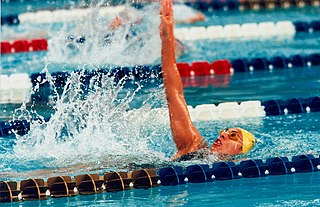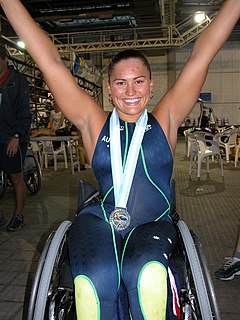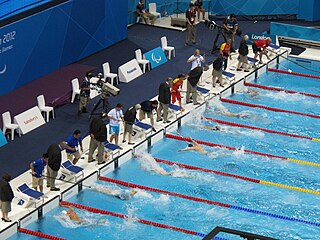
Matthew John Cowdrey is an Australian politician and Paralympic swimmer. He presently holds numerous world records. He has a congenital amputation of his left arm; it stops just below the elbow. Cowdrey competed at the 2004 Paralympic Games, 2006 Commonwealth Games, 2008 Paralympic Games, 2010 Commonwealth Games, and the 2012 Paralympic Games. After the 2012 London Games, he is the most successful Australian Paralympian, having won thirteen Paralympic gold medals and twenty three Paralympic medals in total. On 10 February 2015, Cowdrey announced his retirement from swimming.

S8, SB7, SM8 are disability swimming classifications used for categorizing swimmers based on their level of disability. This class includes a number of different disabilities including people with amputations and cerebral palsy. The classification is governed by the International Paralympic Committee, and competes at the Paralympic Games.
S10, SB9, SM10 are disability swimming classifications used for categorizing swimmers based on their level of disability. Swimmers in this class tend to have minimal weakness affecting their legs, missing feet, a missing leg below the knee or problems with their hips. This class includes a number of different disabilities including people with amputations and cerebral palsy. The classification is governed by the International Paralympic Committee, and competes at the Paralympic Games.
S9, SB8, SM9 are disability swimming classifications used for categorizing swimmers based on their level of disability. Swimmers in this class generally have severe weakness in one leg. This class includes a number of different disabilities including people with amputations and cerebral palsy. The classification is governed by the International Paralympic Committee, and competes at the Paralympic Games.

S7, SB6, SM7 are disability swimming classifications used for categorizing swimmers based on their level of disability. Swimmers in this class have use of their arms and trunk. They have limited leg function or are missing a leg or parts of both legs. This class includes a number of different disabilities including people with amputations and cerebral palsy. The classification is governed by the International Paralympic Committee, and competes at the Paralympic Games.
S6, SB5, SM6 are disability swimming classifications used for categorising swimmers based on their level of disability. This class includes people with a number of different types of disability including short stature, major limb impairment or loss in two limbs. This includes people with cerebral palsy, amputees, and dwarfs. The class competes at the Paralympic Games.
S5, SB4, SM5 are disability swimming classifications used for categorizing swimmers based on their level of disability. The class includes people a moderate level of disability, and includes people with full use of their arms and hands, but limited to no use of their trunk and legs. It also includes people with coordination problems. A variety of disabilities are represented by this class including people with cerebral palsy. The class competes at the Paralympic Games.

S4, SB3, SM4 are disability swimming classifications used for categorising swimmers based on their level of disability. Swimmers in this class have coordination problems affecting all four of their limbs, or have movement in their arms but no trunk or leg function. They also generally have weakness in their hands and arms. A variety of disabilities are represented by this class including people with quadriplegia from spinal cord injury. Events this class can participate in include 50m and 100m Freestyle, 200m Freestyle, 50m Backstroke, 50m Butterfly, 50m Breaststroke, and 150m Individual Medley events. The class competes at the Paralympic Games.
S3, SB2, SM3 are disability swimming classifications used for categorising swimmers based on their level of disability. People in this class have decent arm and hand function, but no use of their trunk and legs. They have severe disabilities in all their limbs. Swimmers in this class have a variety of different disabilities including quadriplegia from spinal cord ijury, severe cerebral palsy and multiple amputations.
S2, SB1, SM2 are disability swimming classifications used for categorizing swimmers based on their level of disability. People in this class have limited use of their arms, and no or extremely limited use of their hands, legs and trunk. Swimmers in this class have a variety of different disabilities including cerebral palsy and amputations.
S1, SB1, SM1 are disability swimming classifications used for categorising swimmers based on their level of disability. The classifications cover athletes with "very severe coordination problems in four limbs or have no use of their legs, trunk, hands and minimal use of their shoulders only". Swimmers in this class have a variety of different disabilities including cerebral palsy.
S13, SB13, SM13 are disability swimming classifications used for categorising swimmers based on their level of disability.

S11, SB11, SM11 are disability swimming classifications for blind swimmers.
Para-swimming classification is a function-based classification system designed to allow for fair competition in disability swimming. The classes are prefixed with "S" for freestyle, butterfly and backstroke events, "SB" for breaststroke and "SM" for individual medley events. Swimmers with physical disabilities are divided into ten classes based on their degree of functional disability. Those with visual impairments are placed in three additional classes: S11, S12 and S13. One more class, S14, is reserved for swimmers with intellectual disabilities. A final class, S15, is for athletes with hearing loss.

The 2013 IPC Swimming World Championships was an international swimming competition, the biggest meet for athletes with a disability since the 2012 Summer Paralympics. It was held in Montreal, Quebec, Canada and lasted from 12 to 18 August. Around 530 athletes competed from 57 different countries. The event was held in the Parc Jean Drapeau Aquatic Complex located at the Parc Jean-Drapeau in Montreal. 172 events were contested with 43 new world records set.

The 2014 IPC Swimming European Championships is an international swimming competition. It was held in Eindhoven, the Netherlands and ran from 4 to 10 August. Around 375 athletes from 35 different countries attended. The venue, the Pieter van den Hoogenband Swimming Stadium, also held the 2010 IPC Swimming World Championships.

The 2015 IPC Swimming World Championships was an international swimming competition for athletes with a disability. It was held in Glasgow, United Kingdom and took place from 13 to 19 July. Around 580 athletes from around 70 different countries competed at the games, with Russia topping the tables with most gold medals and medals won. The event was held at the Tollcross International Swimming Centre located within Tollcross Park in Glasgow. Initially awarded as the IPC Swimming European Championships, the event was upgraded to a World Championship after a change to the IPC calendar.
Swimming at the 2020 Summer Paralympics will be held at the Tokyo Aquatics Centre. There will be 146 events - six less events then the 2016 Summer Paralympics. Swimming is the second largest sport: behind athletics and above table tennis.












